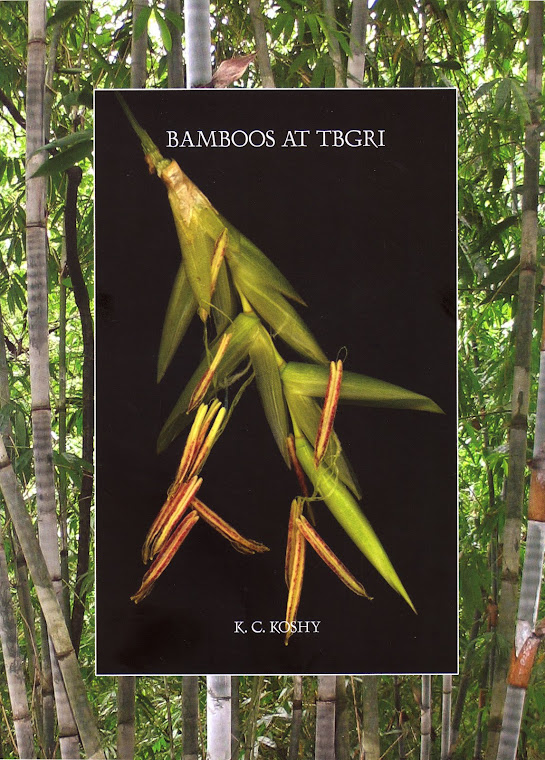Bangladesh Journal of Plant Taxonomy18(2):209-10.2011-
Book review
BAMBOOS AT TBGRI: By K. C. Koshy. Published by the Director, Tropical Botanic Garden and Research Institute, Palode, Thiruvananthapuram 695562, Kerala, India in 2010, Price USD 30(postage free); pp. 104.
This book is a contribution to the documentation of germplasm collection and ex-situ conservation of tropical bamboos. The book contains 104 pages and three chapters.
Chapter 1 deals with TBGRI Bambusetum and major bambuseta of China and India. This chapter provides the historical development of TBGRI Bambusetum with an index map showing contour lines. Notes on the contribution of pioneer scientists who contributed towards the establishment and development of this bamboo garden and dignitaries who visited the Bambuseturn are a special feature of the first chapter. Section on "Advantages of a bambusetum"included in chapter 1 is of good academic interest.
Chapter 2 is the important part and main contents of the book. It includes systematic documentation of live collections of 68 species and one variety under 15 genera, and 12 hybrids produced at TBGRI. The species under each genus are arranged alphabetically. Each species entry includes the Latin name with important citations, a brief description, distributions, records of live collections, locations in the bambusetum with accession numbers. It also records the details of propagules used for planting, their provenances and different hereditary lines conserved. Besides,it provides notes on herbarium collections and spirit materials and notes on flowering where available. Colour photographs of most of the species described, is an important feature of the book that will help all professionals in identifying a living bamboo.
Chapter 3, a brief 2-page chapter with four photographs discusses the future prospects of bamboo breeding.
The identification of bamboos involves more problems than any other group of flowering plants,because most of the bamboos flower once in their life time and die soon after. Flowering of bamboos usually takes place at long intervals (30-120 years). So, identification of bamboos base don floral characters is not always possible. Descriptions based on vegetative characters are also not always complete. Because of identification problem interest in bamboo research is also less among biologists compared to research in other groups. Live collections can help in getting the flowering material that will ultimately help authentic identification and supplying materials for breeding programs. There are bamboo plantations around many organizations, in many home gardens through this sub-continent and in many forest departments' plantations. But systematic information on origin of planting materials, provenances and planting dates are lacking, which are very much needed for methodical research works. TBGRI has taken this novel task of this systematic effort of germplasm collection and conservation. Only who has pursued work on bamboo biology knows how painstaking it is! Dr. K. C. Koshy's efforts in documenting the collections at TBGRI are praise worthy. It will give us a clear picture of flowering and seeding cycles of many bamboo species; genetic diversity among many species and their biology. These collections will also help bamboo taxonomists in documenting vegetative characters along with flowering characters that will make a clear picture of species description. I firmly believe, this book will be good help to taxonomists, breeders, horticulturists and conservation biologists.
There remain some shortcomings in every work. This book also has some shortcomings that need to be mentioned. Use of acronym of an organization in the title of the book could be avoided.TBGRI may not be known to every reader. So, through cross reference one may not know 'what is it or where it is'? It would be clearer if the author had used the full name of the organization and acronym in parenthesis. The map of TBGRI Bambusetum with contour lines and index for accessions is an important feature of the book. But font used in printing accession numbers is too small to be visible in naked eye or by a reading glass. It needs a magnifying glass to read the letters. The map pages also do not open flat and is difficult to read the writings within the fold.
The author could further split Chapter 2. So many entries under a species have made the presentation clumsy. One chapter could be with taxonomic descriptions, geographical distribution and flowering notes. Another chapter could include the accessions of live collections, collection locality, provenances and other information. A key for identification of species based on vegetative characters would make it more users friendly. An auricle of the culm sheath is a good diagnostic character. The author could use it in making botanical descriptions of species.Vernacular names sometimes help general users in tentative identification of a species. The author could cite vernacular names for the species where available.
However, the author is to be congratulated for his painstaking works in collecting and centralizing bamboos from various parts of India and making this documentation as a milestone for future bamboo biologists and conservationists. The book printed in good quality glossy paper with nice cover and good photographs looks smart. I wish its wide circulation.
M. Khairul Alam
